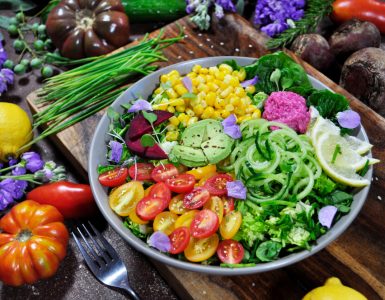Have you ever thought about growing a herb garden?
Editor Jane Garton shares the top herbs to grow and how to create your own herbal corner in your garden, on your patio or along your windowsill.
Herbs are incredibly easy to look after as long they are given the right conditions. And once they are established you can start to make your own herbal infusions as well as using some of them in your cooking.
Although some herbs can be grown from seed it’s sometimes easier to buy plants. They will establish quickly and most will be ready to use immediately. If you don’t have a garden, you can grow herbs in pots, which you can then display on your patio or windowsill.
Here are some great herbs along with their health benefits to get you started:
This striking plant with distinctive white veined leaves grows best in well-drained soil in a sunny position, but you need to make sure you protect the young plants from slugs and snails.
By the end of the summer the purple flowers will have matured into seed heads. Place in a warm dry place and after a few days tap the heads to release the seeds. Prepare as a decoction or grind the seeds and add them to salads.
Benefits:
The seeds of milk thistle contain chemical compounds known collectively as silymarin, which are thought to help boost liver health.
MINT
There are more than 20 different species of mint but peppermint is the one most widely used in herbal remedies. It grows best in a rich moist soil in a sunny or partially shaded spot.
As mint is such a rampant grower it is best to restrain it by starting off with a plant in a large pot, which you can then plunge straight into the ground. Make sure the lip of the container remains above the surface to prevent shoots escaping over the top.
The plant will need watering and a light pruning in summer to keep it bushy. The leaves can be picked at anytime during the growing season and used fresh or dry to make an infusion.
Benefits:
Menthol, the active ingredient in mint, stimulates the production of bile as well as relaxing the stomach muscles, both of which help to improve digestion.
THYME
With its colourful, fragrant foliage, thyme likes a sunny spot and a well-drained, slightly stony soil. It is best to start off with plants, which you can also grow in pots filled with compost.
Thyme should be harvested in summer before it starts to flower. Keep plants compact by lightly trimming over the top after flowering. Thyme can be used dried or fresh as an infusion.
Benefits:
Rich in the volatile oil thymol, thyme has powerful antiseptic, antibiotic and anti fungal properties.
It is good for coughs, throat and chest infections.
With its pretty, small green leaves, sage likes a well-drained sandy soil and plenty of sun. It is best to start off with plants, which will need a light pruning in the summer after flowering to encourage a bushy growth.
The leaves should be harvested just before the plant starts to flower and can be used dried or fresh to make an infusion.
Benefits:
Traditionally associated with longevity, sage is rich in plant oestrogens. Made into an infusion, it may help to combat hot flushes and night sweats and can also be used as a gargle and mouthwash for sore throats. Rubbing fresh sage leaves onto insect bites and stings can also help to bring relief.
A pot or bush of lavender is a must in any herbal corner. Start off with plants, which can be grown in pots filled with gritty compost or in well-drained soil in a sunny spot. If growing in pots, allow the compost to almost dry out between watering and keep on the dry side in winter.
Lavender should be harvested in summer just as the petals start to open. The flowers can be made into oil by infusing fresh blooms in virgin olive oil. Alternatively use dry or fresh as an infusion. A sprig of lavender under your pillow may also help you to sleep at night.
Benefits:
Lavender contains chemical compounds that are thought to help relieve pain and reduce irritability. It can be used to soothe burns, bites and stings as well as to ease insomnia, tension and depression.
This pretty plant, which produces large clusters of vanilla-scented white or pink flowers in the summer, thrives in a moist or well-watered soil in a sunny or partially shaded position. You can start off with seeds or plants.
Once established, you should cut back stems as the flowers fade to prevent plants from self-seeding. After the plant has died back in the autumn the roots can be dried and prepared as an infusion.
Benefits:
Sometimes described as nature’s tranquiliser, valerian contains valerenic acid and substances known as iridoids which are thought to help calm the nerves and promote sleep.
Instantly recognisable by its fragrant leaves, lemon balm thrives in any well-drained soil in a sunny spot. You can start off with seeds or plants. Regularly trimming the shoots will keep plants bushy and produce the tastiest leaves. They can be used dried or fresh to make an infusion.
Benefits:
Volatile oils, such as citral and citronella, give lemon balm anti-spasmodic properties, which can have a calming effect on the central nervous system. Crushed leaves can also be rubbed onto the skin to repel gnats and mosquitoes.























